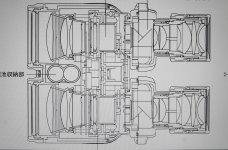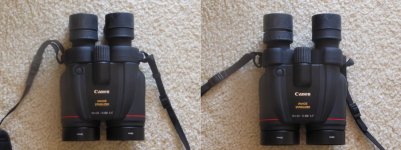Chosun Juan
Given to Fly

Dennis, I don't know if you got the first lot of quoted stuff from the same source, but just because somebody wrote it on the internet, doesn't make it right! :eek!: :brains: :smoke:
Look straight ahead, then close one eye - that field will be way more than 90° (unless you've got a hooter like pinnocchio! ..... If you can only see 90° then get yourself to a specialist stat ! (or a toymaker!
..... If you can only see 90° then get yourself to a specialist stat ! (or a toymaker!  :-O
:-O
Have a look at the attached drawing of the Canon IS .... there's no way any fantasmagorical 3D effect is coming out of that set up ! Take that quoted source of yours with a grain of salt. Far better to rely on your own measurements .... :eat:

Can you measure the Centre line distances for Oculars/Objectives at 3 settings for us with your 10x42 IS ???
1. Bin's minimum IPD
2. Your IPD
3. Bin's maximum IPD.
These can be easily done by measuring from the far outside glass edge of one side to the near glass edge of the other side. :cat:
Chosun :gh:
Look straight ahead, then close one eye - that field will be way more than 90° (unless you've got a hooter like pinnocchio!
Have a look at the attached drawing of the Canon IS .... there's no way any fantasmagorical 3D effect is coming out of that set up ! Take that quoted source of yours with a grain of salt. Far better to rely on your own measurements .... :eat:

Can you measure the Centre line distances for Oculars/Objectives at 3 settings for us with your 10x42 IS ???
1. Bin's minimum IPD
2. Your IPD
3. Bin's maximum IPD.
These can be easily done by measuring from the far outside glass edge of one side to the near glass edge of the other side. :cat:
Chosun :gh:
Last edited:





